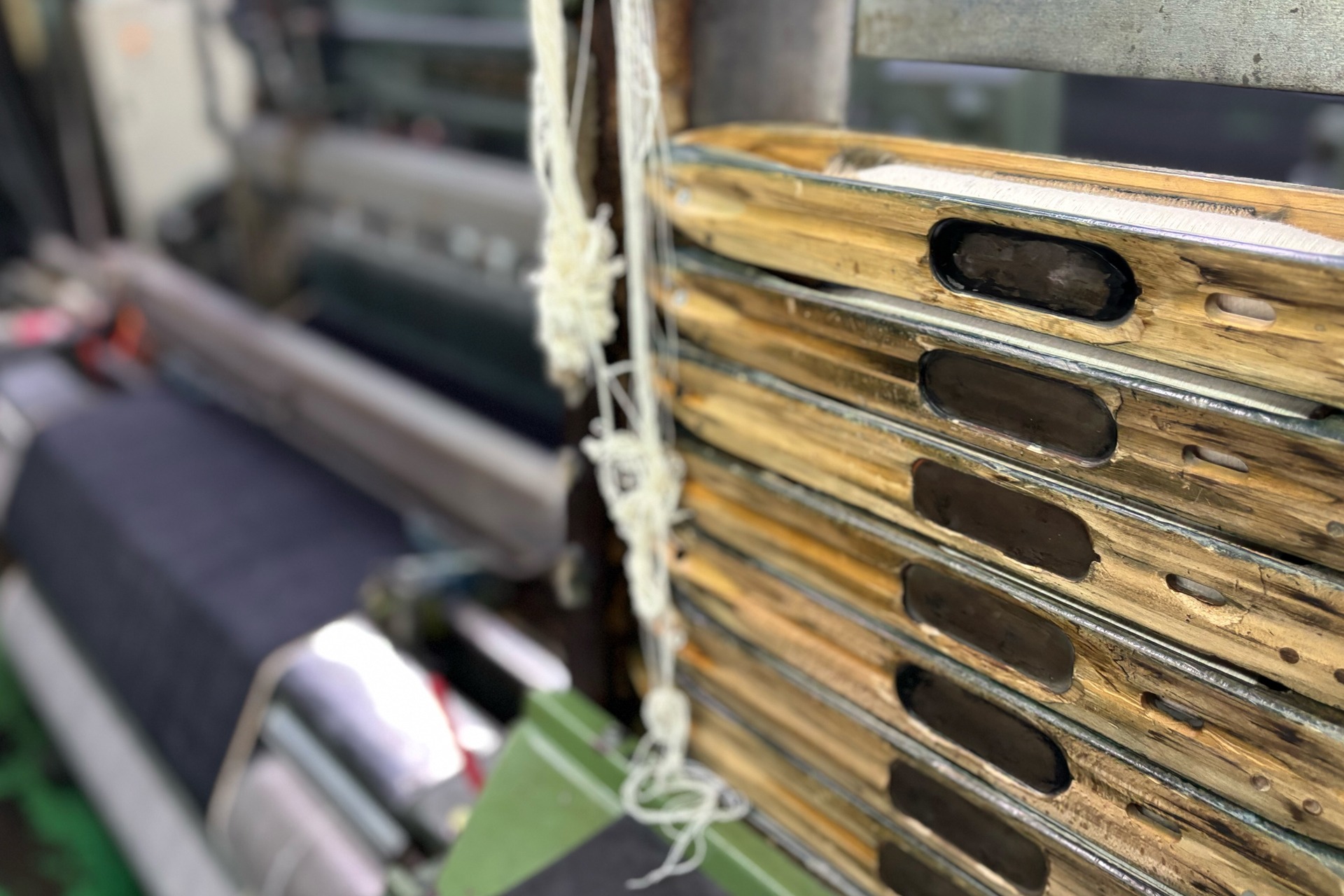2024/08/30 12:45

JAPAN VINTAGE DENIM LAB.を運営している株式会社岡本テキスタイルでは、シャトル織機10台とレピア織機20台を要し、
ヴィンテージの風合いが残るセルヴィッチデニムから広幅のデニム生地などの製織を行っています。
当店で取り扱いのセルヴィッチデニムの表面の凹凸感、ムラ感などのヴィンテージならではの「アジ」は、旧式シャトル織機でないと表現することができません。
また、最新の織機は1日に約350mのデニム生地を製織することができますが、旧式シャトル織機では1日に約120mほどしか織ることができません。
たとえ生産性が悪かったとしても、「本物」のデニムを生産するために、「本物」のシャトル織機を使って生産を続け、
岡山県井原産デニムの伝統を守りつつも岡本テキスタイル流解釈の新しいエッセンスを込めた製織を信念にデニム生地を提供し続けています。
●シャトル織機
シャトル織機とはデニムやキャンバス地などの織物を製作するための機械であり、織機の中でも特に伝統的かつ基本的なタイプの一つで、
経糸(縦糸)と緯糸(横糸)を交差させることで生地を作り出します。
「シャトル / 杼(ひ)or梭(おさ)」と呼ばれる道具を用いて、ピンと張った経糸の間に緯糸を左右に通すことで生地を織っていきます。
このシャトルには、緯糸を巻きつけたボビンが装着されており、シャトルが往復するたびに緯糸が経糸に交わることで織物が形成されます。
●シャトル
シャトルとは織機で緯糸を経糸の間に通すための道具で、織物の生産において重要な役割を果たします。
製織の基本的な工程は経糸と緯糸を直角に交差させることで布地を作ることですが、
この緯糸を織機内で左右に往復させるのがシャトルの役割です。
シャトルは通常、木製やプラスチック製、金属製で作られており、内部にボビン(スプール)がセットされています。
このボビンに緯糸が巻かれており、シャトルが経糸の間を通るたびにボビンに巻かれた緯糸が経糸の間に織り込まれていきます。
シャトルが左右に動く際、経糸の隙間を通り抜けるため、経糸を交互に上下させてその間を通過させる「綜絖(そうこう)」という機構と連動して動きます。
「往復するもの」の代名詞でもあり、シャトルバスやシャトルサービス、スペースシャトルといった単語の「シャトル」は、織機に利用するシャトルからの派生であると言われています。
●歴史
シャトル織機の歴史は古く、初期の織機は手動で操作されていました。
紀元前の時代から簡単な織機が存在していたものの、シャトルを用いた織機が本格的に普及し始めたのは18世紀の産業革命以降です。
特にジョン・ケイが1733年に発明した「フライシャトル(飛び杼)」は、織物産業に革命をもたらしました。
フライシャトルは手動ではなく機械的にシャトルを左右に飛ばす仕組みで、これにより1人の織工が短時間で幅広い布を織ることが可能になりました。
この技術革新は産業革命の進展とともに、織物産業の大規模な発展を促進しました。
これに伴い織物産業はさらに発展し、ヨーロッパを中心に工場制手工業から機械制工場へと移行していきました。
●いま
現代の織物産業ではシャトル織機は部分的に自動化されたシャトルレス織機(エアジェット織機、レピア織機など)を使った生産がほとんどで、旧式のシャトル織機を使った製織は衰退しています。
新型織機はシャトルを使用せずに緯糸を高速で挿入する技術を採用しており、織物の生産速度がさらに向上しました。
また、シャトルが原因となる摩擦や衝撃がないため、織物の品質、均一性も向上しています。
しかし、シャトル織機でしか表現できないアジのある不均一さや表面の凹凸感、両端に施されたセルヴィッチは、今なお愛され続けています。
岡本テキスタイルとして歴史や伝統を守りつつも、今まで蓄積されていった技術、新しい技術・思考も取り入れた、温故知新のデニム生地をこの先も織り続けていきます。
Okamoto Textile Co., Ltd. operates Japan Vintage Denim Lab. and has 10 shuttle looms and 20 rapier looms to weave wide denim fabrics from selvage denim,
which retains a vintage look and feel, and others.
The surface irregularity and unevenness of our selvage denim can only be expressed by using old-style shuttle looms.
Also, the latest looms can weave approximately 350 meters of denim fabric per day, while old-style shuttle looms can weave only about 120 meters per day.
Even if productivity is poor, we continue to produce “real” denim using “real” shuttle looms,
We continue to provide denim fabrics with the belief that we can maintain the tradition of denim produced in Ibara, Okayama Prefecture,
while at the same time weaving fabrics with the essence of new interpretations of the Okamoto Textile style.
[Shuttle Loom]
A shuttle loom is a machine used to produce denim and canvas fabrics, and is one of the most traditional and basic types of weaving machines,
It is one of the most traditional and basic types of looms. It produces fabric by crossing the warp and weft yarns.
The fabric is woven by passing the weft yarns from side to side between the taut warp yarns using a tool called a shuttle or shuttlecock.
The shuttle is equipped with a bobbin on which the weft threads are wound, and as the shuttle moves back and forth, the weft threads cross over the warp threads to form the fabric.
[Shuttle]
The shuttle is a tool used to pass the weft yarns between the warp yarns on a weaving machine and plays an important role in the production of woven fabrics.
The basic process of weaving is to cross the warp and weft yarns at right angles to form a fabric,
The shuttle is responsible for moving the weft yarns back and forth from side to side on the loom.
The shuttle is usually made of wood, plastic, or metal, and has a bobbin (spool) inside.
Weft yarns are wound on this bobbin, and as the shuttle passes between the warp yarns,
the weft yarns wound on the bobbin are woven between the warp yarns.
As the shuttle moves from side to side, it moves in conjunction with a mechanism called an “heddle,”
which alternately raises and lowers the warp threads to pass through the warp threads.
[History]
Shuttle looms have a long history, with the earliest looms being operated manually.
Although simple looms have existed since prehistoric times, it was not until the Industrial Revolution of the 18th century that looms using the shuttle began to spread in earnest.
In particular, John Kay's invention of the “fly shuttle” in 1733 revolutionized the textile industry.
The fly shuttle mechanically flew the shuttle from side to side instead of manually,
enabling a single weaver to weave a wide range of fabrics in a short period of time.
This innovation, along with the progress of the Industrial Revolution, facilitated the large-scale development of the textile industry.
The textile industry developed further as a result of these innovations, and mainly in Europe, there was a shift from factory-based handicrafts to machine-based factories.
[Now]
In the modern textile industry, shuttle looms are mostly used in production with partially automated shuttleless looms (air-jet looms, rapier looms, etc.),
and weaving on old-style shuttle looms is in decline.
Newer looms use a technology that inserts weft yarns at high speed without the use of a shuttle, further increasing the production speed of woven fabrics.
Also, because there is no friction or impact caused by the shuttle, the quality and uniformity of the fabric is improved.
However, the unevenness and surface irregularity that can only be expressed by shuttle looms, as well as the selvedges applied to both ends, continue to be loved even today.
Okamoto Textile will continue to weave denim fabrics with a new and old-fashioned style, incorporating accumulated techniques and new technologies and ideas, while preserving history and traditions.
